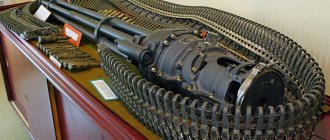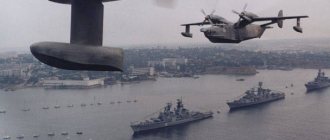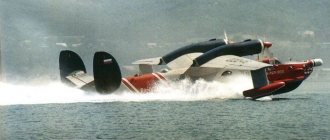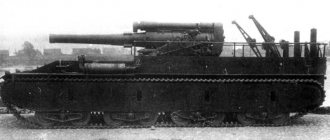GAZ-46 MAV amphibian 1953
Specifications
Equipment NAMI-011
The end of the 1950s and the mid-1960s were the plans of management at the conveyor plant to produce three generations of trucks, which were unified among themselves. The base car was considered to be the new GAZ 52, which became the successor to the GAZ 51A truck, which also had a 4x2 wheel formula and a load capacity of 2,500 kilograms. When they created the car, they tried to take into account that the main area of application of the truck would be urban transportation and operation in rural areas. Taking these points into account, the design features of the car should have ensured good maneuverability and fairly good cross-country ability along with a smooth ride, because asphalt roads were quite rare to find.
photo of GAZ-46
GAZ-46
-
an amphibian
is a Soviet amphibious vehicle, which was produced at the Gorky Automobile Plant since 1953.
In the Soviet Army, this vehicle received the designation “ MAV
” - a small waterfowl vehicle. The main purpose of this vehicle was to support the actions of reconnaissance units, as well as to carry out engineering work on reservoirs. The experience of the end of World War II demonstrated the strengths and weaknesses of various Soviet military equipment, as well as gaps in its development. So there were no domestic floating cars in the army. At the same time, the all-wheel drive four-wheeled Ford GPA amphibians and six-wheeled DUKW trucks received under the Lend-Lease program made it easier for Soviet troops to cross the rivers of Eastern Europe at the final stage of the war. It is quite natural that the military took note of this military equipment and, after the end of the conflict, it was included in the long-term rearmament plan along with other models. In the USSR, the design of both passenger cars and cargo amphibious vehicles began.
First of all, the Soviet military was interested in a light command vehicle that could cross various water obstacles and move in the same group with armored vehicles. the GAZ 46 MAV eventually became an analogue of the floating Ford GPA jeep in the USSR
— a small waterfowl vehicle.
photo of GAZ-46
Immediately after the end of World War II, work was initiated at the Moscow Research Automobile and Automotive Engine Institute (NAMI) to create a floating vehicle built on the basis of the components and mechanisms of the GAZ-67 all-wheel drive SUV, which was well mastered by Soviet industry. New amphibian
it was decided to develop with an eye on the American amphibious SUVs Ford GPA, which began to enter the American army in 1942. At the same time, Moscow engineers from NAMI decided to creatively rework the American idea. On July 22, 1948, the Engineering Committee of the USSR Armed Forces approved the final tactical and technical requirements for the designed amphibious vehicle, which was named NAMI-011 and the military designation MAV. The vehicle was intended for transporting small reconnaissance and other groups over land and crossing various water obstacles, towing light boats or other light trailers, pontoons and other watercraft used by engineering units of the Soviet Army on the water surface.
photo of GAZ-46
However, there was one catch in creating such a machine. The fact was that the GAZ-67 SUV, designed during the war years, was becoming outdated, and a new all-terrain vehicle, the GAZ-69, was preparing to replace it. Despite this, at the end of April 1949, prototypes of the NAMI-011 floating vehicle were already built, and in May of the same year they underwent a series of factory tests. Soon, in the summer of 1949, field tests of the new product followed, and in the fall - interdepartmental tests, which took place in the vicinity of Leningrad. All tests were quite successful. So successful that after their completion, the creators of the floating car NAMI-011 were awarded the Stalin Prize of the 3rd degree “For work in the field of mechanical engineering.”
photo of GAZ-46 rear view
Later, one of the prototypes of the NAMI-011 car, along with all the available technical documentation for the car, was transferred to GAZ. It was in Gorky, after seemingly minor improvements to the design, that serial production of the amphibian was to be established. Moreover, in addition to the outdated design of the GAZ-67 car itself, there was another problem. The thing is that NAMI engineers coped with their task, but their floating car was literally made “on the knee.” The car drawings received from Moscow had inconsistencies, which was quite normal for pilot production, but absolutely unacceptable for serial production. At the same time, it was very dangerous not to comply with the government decree at that time, and a separate group was created at GAZ, headed by V. A. Kreshchuk. This group began working on technical documentation and correcting mistakes made by US. At the same time, in Gorky back in 1944, when the enterprise was considering the possibility of creating its own amphibian based on the GAZ-67, they came to the conclusion that such an idea was absolutely futile. Launching a car into mass production required a lot of significant technological changes, which NAMI managed to overcome in various ways that were unsuitable for serial production when building prototypes. At the same time, GAZ initially relied on the “sixty-ninth”, in which the possibility of future conversion into a floating version was taken into account from the very beginning.
photo of GAZ-46
It would be more logical and cheaper to simply reject the option created by US. But not in the USSR. It was unthinkable to ignore the direct instructions of the government and abandon the design of the machine that received the Stalin Prize. Therefore, in the fall of 1950, GAZ-011 (aka NAMI-011)
was ready to go on the assembly line in Gorky. At the same time, the enterprise carried out parallel work under the leadership of designers A. A. Smolin and G. M. Wasserman on the creation of an amphibian based on the units of the GAZ-69 SUV, which received the new designation GAZ-46. Both the GAZ-011 floating car and the GAZ-46 work at the plant were carried out quite thoroughly. Andrey Lipgart, the chief designer of the enterprise, hoped that the GAZ-011 and GAZ-46 amphibians would go out for testing at the same time, and the customer would be able to choose a newer design.
In 1951, the Engineering Committee of the USSR Armed Forces carried out control tests of the GAZ-011 car, modified by V. A. Kreshchuk’s group. The amphibian turned out to be quite good in the end. The designers have significantly reduced its weight, increased its speed and improved its reliability. The military also approved the GAZ-011. As a result of this, a situation arose where the plant could no longer refuse to produce an amphibian based on the GAZ-67 SUV, but there was no way to produce it either, especially in the context of the deployment of production of the more modern GAZ-69. It was also quite difficult to start mass production of the GAZ-46 amphibian, since the military liked its competitor so much. All this confusion with two parallel projects continued until in 1952, designer Kreshchuk personally sent a letter to Comrade Stalin by secret mail, which told about the situation with floating cars at the plant.
photo of NAMI-011 or GAZ-011
The reaction to this letter was not long in coming; caps flew off at the enterprise; well, no one had been imprisoned yet, but many officials and designers of the plant and various departments were demoted. Also, the resolution of the Council of Ministers dated March 14, 1951, number 981, on awarding the Stalin Prize to the designers of the floating car “NAMI-011” was cancelled. And in Gorky they decided to assemble the GAZ-46. At the same time, the plant fulfilled the production plan for the GAZ-011 in 1953 100%; a total of 68 copies of this car were produced. After which it was replaced by a new GAZ-46 car.
Soviet amphibian MAV GAZ-46: birth in agony
In 1953, a very interesting machine appeared in the USSR. She could travel by land any way and anywhere she wanted. On the water it reached a speed of 4 knots (8 km/h). There was even a project for an amphibian with hydrofoils based on it. Her birth was associated with a loud scandal and the dismissal of many officials. And near Minsk, already in our days, this car was restored and improved. Our guest is MAV GAZ-46.
Ford GPA
During World War II, Canada, England and the United States sent large quantities of military equipment to the USSR, including Ford GPA amphibious SUVs and DUKW (6x6) trucks. These vehicles were used to transport people, equipment and cargo across many rivers in Eastern Europe during the offensive against Germany. After the end of the war, the Soviet Union decided to create two similar machines. This is how the MAV GAZ-46 appeared - an analogue of the Ford GPA, and the ZIL-485 - an analogue of the DUKW. Today we will talk about MAV.
MAV GAZ-46
The abbreviation translates as “small waterfowl vehicle.” The vehicle is designed to support the operations of reconnaissance units, as well as to carry out engineering work on the water. His path to the conveyor was very thorny
BAV (large waterfowl vehicle) ZIL-485 is a Soviet amphibian based on the ZIL truck. It was capable of transporting 25 people or up to 2.5 tons of cargo, including cars and artillery pieces, across water barriers. To make loading easier, the tailgate is hinged. There is a winch and rutted ladders.
Immediately after the end of the war, work began at the Scientific Research Automobile and Motor Vehicle Institute (NAMI, Moscow) to design a floating vehicle based on the components and mechanisms of the GAZ-67 all-wheel drive SUV, which was well mastered in production. They decided to create a new amphibian with an eye on the American Ford GPA waterfowl SUVs, which entered the American army in 1942. It was necessary to creatively rework the American idea.
On July 22, 1948, the Engineering Committee of the Armed Forces approved the tactical and technical requirements for the designed amphibious vehicle, which received the name NAMI-011 and the military MAV. The vehicle was intended for transporting small reconnaissance and other groups by land and crossing water obstacles, towing light boats or other light trailers, pontoons and other floating equipment used by engineering units.
The Soviet SUV GAZ-67 saw plenty of action on the fronts of the Great Patriotic War. Produced from 1943 to 1953.
But there was one catch in the case. The fact is that the GAZ-67, designed during the war, was becoming outdated and the GAZ-69 was preparing to replace it. Nevertheless, at the end of April 1949, prototypes of NAMI-011 were already built, and in May they passed factory tests. Soon, in the summer, field tests followed, and in the fall - interdepartmental tests in the vicinity of Leningrad. Everything went well. So successful that after completion of the tests, the creators of NAMI-011 were awarded the Stalin Prize, 3rd degree, “For work in the field of mechanical engineering.”
NAMI-011 is not the most successful initial version of a small “waterfowl” car
Then one of the prototypes of NAMI-011 and all the available technical documentation for the vehicle were transferred to GAZ, which, after seemingly minor improvements to the design, was to master mass production. However, in addition to the outdated design of the 67, there was another problem. The fact is that NAMI coped with its task, but the car was literally made “on the knee”. The drawings received from US had inconsistencies, which is normal for pilot production, but unacceptable for serial production.
GAZ-46 - the hero of the film “Treason in Slovakian Style”
Failure to comply with the government decree was very dangerous at that time, and GAZ created a separate group under the leadership of V.A. Kreshchuk, which was engaged in developing technical documentation and correcting NAMI errors. At the same time, GAZ back in 1944, when the plant was considering the possibility of creating an amphibian based on the GAZ-67, came to the conclusion that the idea was completely unpromising. Launching into a series for mass production required too many serious technological changes, which at NAMI, when creating prototypes, were overcome in various ways that were unsuitable for mass production. The Gazovians initially relied on the “sixty-ninth”, which initially took into account the possibility of converting the car into an amphibian. And how can the plant produce a model from the old components and assemblies of the GAZ-67, which is about to be replaced by the 69th? We would have to produce obsolete parts in parallel with new ones...
It would have been more logical and cheaper to simply reject the option developed by US. But not in the Soviet country. How could the government's instructions be ignored? Abandon the design that won the Stalin Prize? It was like death...
NAMI-011 and GAZ-46. The longer car is GAZ. These are two amphibians very similar to each other. But one of them had no prospects...
Therefore, in the fall of 1950, GAZ-011 (aka NAMI-011) was ready to be put on the assembly line. At the same time, the plant carried out parallel work under the leadership of designers G.M. Wasserman and A.A. Smolin on an amphibian based on GAZ-69 units, which received the index GAZ-46. Work on both GAZ-011 and GAZ-46 was carried out thoroughly. The chief designer of the plant, Andrei Lipgart, expected that GAZ-011 and GAZ-46 would go out for testing at the same time, and the customer would choose the newer design.
In 1951, the Army Engineering Committee carried out control tests of the GAZ-011, modified by V.A. Kreshchuk’s group. The car turned out to be quite good in the end. Designers have significantly reduced weight, increased speed and improved reliability. The military approved the 011th. The following situation arose: the plant could not refuse to produce an amphibian based on the GAZ-67, but there was also no way to produce it. It was also difficult to start production of the GAZ-46, since the military liked its competitor so much. All this confusion continued until in 1952, a letter from designer Kreshchuk about the situation with amphibians at the plant was sent by secret mail to Comrade Stalin, as a result of which hats flew off... It’s good that no one was imprisoned or shot, but many designers and officials of the plant and various departments were demoted. Resolution of the Council of Ministers of March 14, 1951 N 981 on awarding the Stalin Prize to the designers of “NAMI-011” was cancelled.
Resolution of the Council of Ministers of the USSR N 2286-866ss, dated May 15, 1952: “... a) Through the fault of the Ministry of Automobile and Tractor Industry (Comrades Khlamov and Garbuzov), the GAZ-67 floating car, developed by NAMI, was transferred in 1950 for production GAZ with serious shortcomings and without proven technical documentation; b) Through the fault of MATP (comrade Khlamov) and the Military Ministry of the USSR (comrades Bogdanov, Galitsky and Datsyuk), the designers of NAMI vol. Shishkin, Arkharov, Goranov and others incorrectly received the Stalin Prize for the unfinished design of a floating car.”
As a result, it was decided to produce the GAZ-46. The plant fulfilled 100% of the production plan for 011 in 1953, producing 68 copies of amphibians. After that, it was replaced by the GAZ-46.
By the way! There is one surviving copy of the GAZ-011 in Belarus; it can be found in a children's technical facility near Slutsk, which we once wrote about.
So, what was interesting about '46? The body of the MAV GAZ-46 is made of steel, the engine and transmission compartment is in the front, the crew and passenger compartment is in the center, the spare wheels are laid horizontally on the rear upper platform. The driver and commander have separate seats, with a three-seater bench behind them. The wind deflector can be folded onto the hood, and if necessary, a canvas awning can be raised over the crew compartment. The vehicle moves through the water using one three-bladed propeller mounted at the rear of the hull and driven from the main engine; Before entering the water, a wave barrier is raised at the front to cover the engine and crew separation from water (and prevent the bow from “burying” itself in the water).
Quite interesting experiments were carried out with the GAZ-46 to install it on hydrofoils to give it greater speed on the water. However, work in this direction was curtailed, since the time spent on installing hydrofoils significantly exceeded the gain in speed of overcoming water obstacles.
The GAZ-46 was equipped with a 2.1 liter 4-cylinder engine (52 hp), the same as in the GAZ-M20 Pobeda. The transmission and wheel suspension were unified with the GAZ-69. The engine was mated to a manual 3-speed gearbox and a 2-speed transfer case. We have already told you what GAZ-69 is.
Interestingly, the amphibian had wheels of a special design, which made it possible to improve cross-country ability by moving on flat tires without the risk of them turning and water getting inside. On the instrument panel there was a tachometer and...a signal light for the appearance of water in the hold!
Production of the GAZ-46 continued until 1958. The production of the basic GAZ-69 vehicle moved to UAZ, so it was planned to launch the production of the GAZ-46 there as well. But in Ulyanovsk at that time there was no possibility of producing the GAZ-46. And the military had no particular need for this car, which was the reason for the cessation of production. According to unverified information, no more than 654 copies were produced. So today it is a very rare and exclusive car.
By the way, in Belarus, the private research and production enterprise “ProKarEngineering” in the 2000s. improved the GAZ-46. The car was designed almost from scratch. The company exists today and continues to do interesting projects. We have written about them several times (“How to legalize the “remodeling” of a car. The history of the legalization of one tuning project”, “A partisan’s dream, or How to modify the best”, “ZIL-157: a second life for a legend”).
You can read in more detail about the improvement of the GAZ-46 by Belarusians in the ABS magazine previously published by our editors. An interesting Belarusian project appeared in the Russian press.
GAZ-46 owner's opinion
After purchasing the car (it was miraculously found), repairs intermittently took 6 long years. The biggest difficulties arose with my relatives, who walked around and laughed, saying what a monster I had bought and how much money I had wasted.
The production of the GAZ-46 was not in demand by the troops due to technical imperfections and the military also did not have an urgent need for this model; its serial production was closed. The remaining amphibians in military units lived out their lives, rusting in the outskirts. At that time, it was impossible for civilians to buy such equipment; only a few copies received documents.
I disassembled everything that remained undisassembled and began to restore it according to the drawings. First I digested the body. I painted it and started assembling the chassis. The engine was taken from GAZ-24, because Pobeda’s native didn’t want to insert it. In my opinion, it is rather weak for a 2.5-ton vehicle. And the 24th copes quite well, but during operation it turned out that the design features are such that cooling occurs with great difficulty, because the engine is in the hold. The plans include a diesel engine.
The 3-speed gearbox, transfer case and propeller are original. The bridges are original, but there are plans to replace them with military ones for better maneuverability, because... no blocking. It was not possible to find the original wheels, since they were dismountable for ease of vulcanization in the field. That's why I installed it from UAZ. In general, I collected it for a long time and difficultly, it is impossible to tell everything. The most interesting thing is that it is almost impossible to drive it on city roads - curious people do not allow entry only after 12 at night, when the streets are empty. I've been afraid to swim since childhood. Especially by car...
Yuri GLADCHUK Photo from open sources ABW.BY
Description of design
Buoyancy MAV
provided a welded steel body on a frame made of box sections.
It was a pontoon type building with no doors. The inside of the floating car was divided by vertical transverse partitions into 3 compartments: bow, middle and stern. In the bow compartment of the car there was an engine-transmission compartment (MTO). The middle compartment was the cabin for the crew and passengers, and in the rear there was a luggage compartment. On the bow of the floating car there was a reversible wave barrier, which was raised by the crew before the car entered the water. The shield or screen prevented the car from “burying its nose” in the water, and also protected the air intake, necessary for cooling the engine, and the central compartment from water ingress. Between the headlights there was a bollard, necessary for mooring the amphibian on the water, and a capstan for the rescue buoy. Lever shock absorbers were installed outside the GAZ-46 body, and spare wheels were placed on the rear upper platform. The GAZ-46 floating car was equipped with a 4-cylinder engine from the GAZ-M20 Pobeda passenger car, and the wheel suspension and transmission were borrowed from the GAZ-69 SUV. engine
was connected to a manual gearbox, which had three forward and one reverse gears, and a two-speed transfer case. On the water surface, the car could move with the help of a three-bladed propeller, which was driven by a driveshaft from the transfer case. The direction of movement of the car in the water could be changed by a water rudder, which was placed in a stream of water thrown by the boat's propeller. A distinctive feature of the GAZ-46 (MAV) amphibian was the wheels of a special design; to increase cross-country ability, they made it possible to drive on flat tires without any risk of them turning and water getting inside the tire.
photo GAZ-46 engine
Since the car was floating, all its electrical wiring was made with sealed electrical connectors; the ignition distributor, which was completely sealed, did not need additional protection. A muffler and exhaust pipe were installed on the bow deck of the floating GAZ-46 car. True, the muffler created so much noise that it unmasked the car. On the other side of the bow deck there was a gas tank neck, that is, if the need arose, it was possible to refuel the fuel tank directly on the water.
photo of GAZ-46 cockpit
The design of the cockpit, if it is appropriate to use such a loud definition here, was spartanly simple, since the floating car was originally designed on the instructions of the military. There was simply no special level of comfort provided for either the crew or passengers. And according to the general design of the floating car GAZ-46
, rather, it looked like a boat.
The MAV instrument panel was completely borrowed from the GAZ-69 SUV. At the same time, there was a tachometer and a warning light on the instrument panel, which notified about the appearance of water in the hold. The transmission control levers were on the right side of the driver. The pedal brackets were distinguished by their unusual shape and were located close to each other in order to have as few different technological holes as possible through which water could get inside the car body. The windshield frame could be laid on the hood, and a canvas awning could easily be stretched over the passenger compartment. The front row of seats included two chairs: for the commander and the driver. Behind them was mounted a three-seater bench that had no adjustments. For ease of maintenance, a fuel filter was installed in the vehicle's cabin. The amphibious vehicle GAZ-46 (MAV)
entered service with individual transport and landing battalions, as well as individual pontoon-bridge regiments; in addition, it was exported to countries that were parties to the Warsaw Pact. Production of the car continued in the Soviet Union from 1953 to 1958, when production of the basic GAZ-69 was transferred to the UAZ plant. At the same time, in Ulyanovsk there was simply no production capacity to continue the production of a floating car, which, along with the small need for such machines, was the reason for the cessation of their production. In addition, the first BRDMs had already begun to arrive in the army. There is no exact information on the number of MAVs produced, but, apparently, about 650 of these vehicles were assembled in total.











